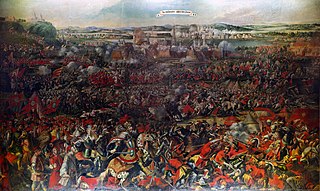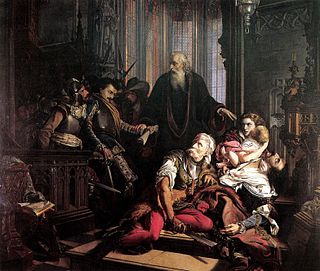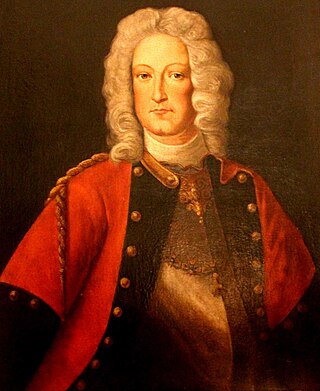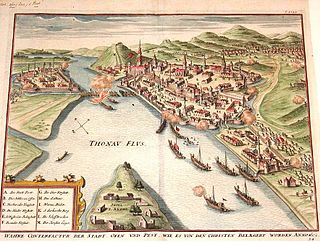
Ahmed II was the sultan of the Ottoman Empire from 1691 to 1695.

The Battle of Vienna took place at Kahlenberg Mountain near Vienna on 12 September 1683 after the city had been besieged by the Ottoman Empire for two months. The battle was fought by the Holy Roman Empire and the Polish–Lithuanian Commonwealth, both under the command of King John III Sobieski, against the Ottomans and their vassal and tributary states. The battle marked the first time the Commonwealth and the Holy Roman Empire had cooperated militarily against the Ottomans. The defeat was a turning point for Ottoman expansion into Europe, after which they would gain no further ground. In the ensuing war that lasted until 1699, the Ottomans would cede most of Ottoman Hungary to Leopold I, Holy Roman Emperor.

Emeric Thököly de Késmárk was a Hungarian nobleman, leader of anti-Habsburg uprisings like his father, Count István Thököly, before him. Emeric was Prince of Upper Hungary, an Ottoman vassal state, from 1682 to 1685, and briefly Prince of Transylvania during the year 1690. Having formed an alliance with the Turks, Thököly assisted the Ottoman Empire at the Battle of Vienna in 1683 and led the Turkish cavalry at the Battle of Zenta. Refusing to surrender to Habsburg Emperor Leopold I, Thököly lost his principality of Upper Hungary and finally retired to Galata, near Constantinople, with large estates granted him by Mustafa II.

The Battle of Slankamen was fought on 19 August 1691, near Slankamen in the Ottoman Sanjak of Syrmia, between the Ottoman Empire, and Habsburg Austrian forces during the Great Turkish War.

Nagykanizsa, known colloquially as Kanizsa, is a medium-sized city in Zala County in southwestern Hungary. It is a city with county rights.

Francis II Rákóczi was a Hungarian nobleman and leader of the Rákóczi's War of Independence against the Habsburgs in 1703–1711 as the prince of the Estates Confederated for Liberty of the Kingdom of Hungary. He was also Prince of Transylvania, an Imperial Prince, and a member of the Order of the Golden Fleece. Today he is considered a national hero in Hungary.

Kuruc, also spelled kurutz, refers to a group of armed anti-Habsburg insurgents in the Kingdom of Hungary between 1671 and 1711.

The Battle of Sisak was fought on 22 June 1593 between Ottoman Bosnian forces and a combined Christian army from the Habsburg lands, mainly the Kingdom of Croatia and Inner Austria. The battle took place at Sisak, central Croatia, at the confluence of the Sava and Kupa rivers, on the borderland between Christian Europe and the Ottoman Empire.

The Battle of Zenta, also known as the Battle of Senta, was fought on 11 September 1697, near Zenta, Kingdom of Hungary, between Ottoman and Holy League armies during the Great Turkish War. The battle was the most decisive engagement of the war, and it saw the Ottomans suffer an overwhelming defeat by an Imperial force half as large sent by Leopold I, Holy Roman Emperor.

The Battle of Saint Gotthard, of the Austro-Turkish War (1663–1664), took place on 1 August 1664 on the Raab between Mogersdorf and the Cistercian monastery St. Gotthard in West Hungary. It was fought between Imperial Army forces, including German, Swedish and French contingents, led by Imperial commander-in-chief Count Raimondo Montecuccoli and the army of the Ottoman Empire under the command of Köprülü Fazıl Ahmed Paşa.

Rákóczi's War of Independence (1703–1711) was the first significant attempt to topple the rule of the Habsburgs over Hungary. The war was conducted by a group of noblemen, wealthy and high-ranking progressives and was led by Francis II Rákóczi and resigned soldiers and peasants fought alongside the noblemen. The insurrection was unsuccessful, ending with the Treaty of Szatmár; however, the Hungarian nobility managed to partially satisfy Hungarian interests.

The Habsburg monarchy and the Ottoman Empire waged a series of wars on the territory of the Kingdom of Hungary and several adjacent lands in Southeastern Europe from 1526 to 1568. The Habsburgs and the Ottomans engaged in a series of military campaigns against one another in Hungary between 1526 and 1568. While overall the Ottomans had the upper hand, the war failed to produce any decisive result. The Ottoman army remained very powerful in the open field but it often lost a significant amount of time besieging the many fortresses of the Hungarian frontier and its communication lines were now dangerously overstretched. At the end of the conflict, Hungary had been split into several different zones of control, between the Ottomans, Habsburgs, and Transylvania, an Ottoman vassal state. The simultaneous war of succession between Habsburg-controlled western "Royal Hungary" and the Zápolya-ruled pro-Ottoman "Eastern Hungarian Kingdom" is known as the Little War in Hungary.

During the siege of Naģykanizsa in 1601, a small Ottoman force held the fortress of Naģykanizsa in western Hungary against a much larger coalition army of the Habsburg monarchy, while inflicting heavy losses on its besiegers.

CountAdam II. Batthyány was a Hungarian general and nobleman. He served as ban (viceroy) of Croatia from 1693 to 1703.

Ferdinand-Gobert Count of Aspremont-Lynden was an Austrian military from the Southern Netherlands who fought in the service of the Habsburg Emperor Leopold I.

The Habsburg–Ottoman war of 1565–1568 was a conflict between the Habsburg Empire and the Ottoman Empire fought mainly on the territory of Hungary and Croatia. During the war, the Turks captured the castle at Szigetvár but the death of Sultan Suleiman I forced them to retreat. The war ended in 1568 after the signing of a peace treaty in Edirne, under which both sides retained their territorial gains, and the Habsburgs further pledged to pay tribute of 30,000 forints to the Turks.

The Winter Campaign, also known as the Osijek campaign, was the campaign of Nikola VII Zrinski, Ban of Croatia, in the winter of 1664, during which he and his army penetrated 240 km into Turkish territory. Between 1663 and 1664. This campaign most important operation of the Turkish Campaign in 1664, which was also the main success of the Christian forces. The history of the campaign is that in 1663 the Turks attacked Hungary with an army of almost 80,000 people. The king appointed Zrinski as the commander-in-chief of the Croato-Hungarian troops, who, with his successful enterprise, set fire to the Osijek bridge that provided supplies to the Turkish garrisons across the Danube, but due to the court's delay, he was unable to capitalize on the victory. Kanizsa Bécs, who saw a political opponent in Zrinski, who fought with pen and sword, replaced him after a siege that ended in failure.

The Siege of Kanizsa was an unsuccessful military operation carried out by Miklós Zrínyi to capture the Ottoman fortress of Kanizsa, the combined Hungarian-Austrian-German army on hearing of the incoming Turkish reinforcements had to withdraw after a month-long siege.

The Battle of Zsarnóca took place on May 16, 1664, between an Austrian division commanded by General Jean-Louis Raduit de Souches with 11,000 troops and an Ottoman division commanded by Kücsük Mehmed Pasha with 15,000 troops. The battle ended in an Austrian victory and death of Kücsük Mehmed Pasha who fell in battle.

The siege of Buda took place in 1602 during the Long Turkish War and was the second of three attempts to capture the town by the Habsburgs; however, it ended in failure, despite the Habsburg capture of Pest.























